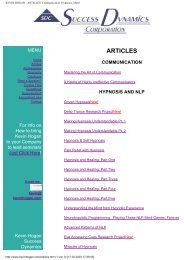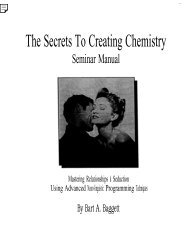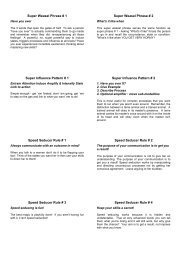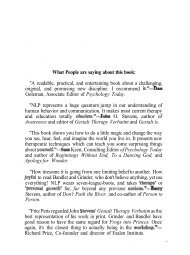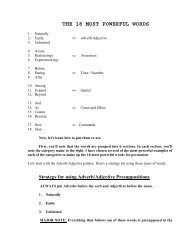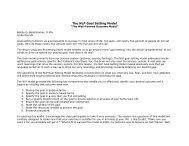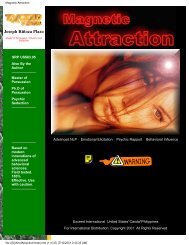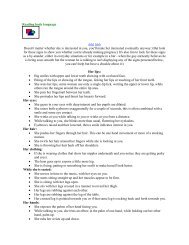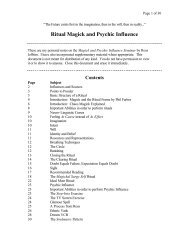A Pragmatic Guide To Communication & Change.pdf - NLP Info Centre
A Pragmatic Guide To Communication & Change.pdf - NLP Info Centre
A Pragmatic Guide To Communication & Change.pdf - NLP Info Centre
- No tags were found...
You also want an ePaper? Increase the reach of your titles
YUMPU automatically turns print PDFs into web optimized ePapers that Google loves.
trust: within the context of effective communication, trust is the sense a person gets when<br />
he believes he is being<br />
148<br />
mind reading: a Meta Model violation in which a person expresses the idea that it is<br />
possible to know what someone else is thinking or feeling with little or no diret feedback.<br />
(99104)<br />
mirroring: see "rapport." (66)<br />
modal operators: Meta Model violations which identify limits to a person's model of the<br />
world. Modal operators of necessity (93-94) are exemplified by imperatives such as<br />
"should," while modal operators of possibility (94-96) are exemplified by words such as<br />
"can't."<br />
model: a representation of a thing or process which is useful as a tool for better<br />
understanding what it represents and for predicting how it will operate in various<br />
situations. A model is a generalized, deleted, and distorted copy of that which it<br />
represents. (1-2)<br />
model of the world: a perceptual representation of our experiences of the world. A<br />
personal model of "reality," it differs from person to person depending on their<br />
neurological make-up and social and individual experiences. (2, 16)<br />
neurological constraints: the filters of our brain and sensory organs. Differences in<br />
people's "sensitivity" to various stimuli accounts in part for differences between people's<br />
models of the world. (17-20)<br />
nominalization: a Meta Model violation in which an "abstract noun" is formed by taking a<br />
verb (such as "relate") and changing it by the process of linguistic distortion into a noun<br />
(like "relationship"). A nominalization differs from a "concrete noun" which names a<br />
person, place, or thing. (8490)<br />
nominalized: dissociated from kinesthetic aspects of experience through the use of<br />
language. A "digital" is often described as being "nominalized." (85, 88)<br />
pacing: see "rapport." (66)<br />
oeeular accessing cues: see "accessing cues." (115-122)<br />
perceptual enhancer: the effects of language on our perception. See also "social<br />
constraints." (69)<br />
predicate preference: the habitual use of certain predicates - verbs, adverbs, and adjectives<br />
- which indicate systematic use of one of the representational systems to express thoughts<br />
more often than the others. Predicate preference is often a good indication of a person's<br />
preferred representational system. (37)<br />
preferred representation system: the system in which a person makes the most number of<br />
distinctions about himself and his environment. The habitual use of one system more<br />
often than the others to sort out and make sense of experiences. (38)<br />
pupil response: an unconscious response to emotional arousal. Directed by the autonomic<br />
nervous system, the pupils dilate when a person is exposed to pleasant stimuli and<br />
constrict when he is exposed to an unpleasant situation. (113-114)<br />
rapport: during effective communication, rapport is established through communicative<br />
behaviors called "pacing." These subtle forms of feedback elicit in the observer a sense of<br />
being like and of trusting the communicator. Two methods of pacing that result in rapport<br />
are matching a person's predicate preference and "mirroring" (matching) a person's



